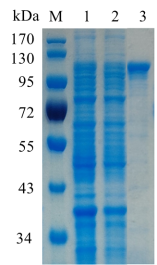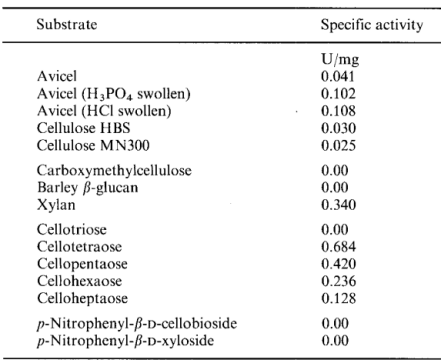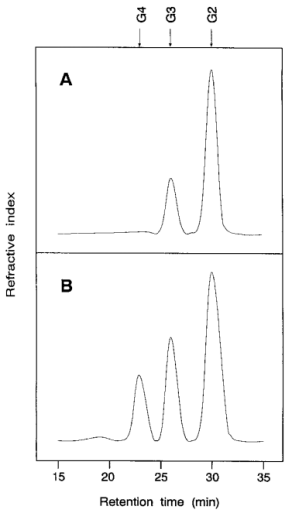CsGlu48A(exo-β-1,4-Glucanase)
CsGlu48A
Ex-Glu0024
(EC.3.2.1.91) exo-β-1,4-Glucanase
CAZy Family: GH48
PROPERTIES
1.ELECTROPHORETIC PURITY
-Single band on SDS-gel electrophoresis (MW ~105kDa)

Figure 1. Electrophoresis analysis of CsGlu48A. M, molecular weight marker (PageRuler Prestained Protein Ladder, Thermo Scientific); lane 1, culture lysate before IPTG induction; lane 2, culture lysate after IPTG induction; lane 3, CsGlu48A purified from Ni sepharose fastflow column.
2.SPECIFIC ACTIVITY
0.68 U/mg protein (on cellotetraose) at pH5.5 and 70°C
One Unit activity is defined as the amount of enzyme required to release 1 μmol of glucose per minute from cellotetraose (5mM) in MES buffer(50mM) pH5.5.
3.RELATIVE RATES OF HYDROLYSIS OF SUBSTRATES
Table 1. Relative activity of ClGlu48A on different substrates


Figure2.HPLC analysis of degradation products released from avicel.Standard reaction mixtures containing 1 % (massjvol.) suspension of avicel (A) or HC1-swollen avicel (B) were incubated for5min at 70T. G2, cellobiose; G3, cellotriose;G4,cellotetraose.
4.PHYSICOCHEMICAL PROPERTIES
pH Optima:6.0
pH Stability:5.0-7.0
Temperature Optima:70°C
Temperature Stability:<80°C

Fig. 3.pH profile of CsGlu48A activity.Incubations were carried out for 16 h at 70°C in reaction mixtures containing 50 mM acetate (A), citrate(O),Mes (0), or phosphate(A)at the indicated pH values

Fig. 4.Temperature profile of CsGlu48A activity.Incubations were carried out at the indicated temperatures for 12 h in 50 mM Mes, pH 5.8, with(0)or without (0) addition of 10 mM CaC12, using HCI-swollen avicel as substrate.
5.STORAGE CONDITIONS
The enzyme should be stored at -20°C. For assay, this enzyme should be diluted in Tris-HCl buffer (20 mM) pH8.0. Swirl to mix the enzyme immediately prior to use.
6. REFERENCES
[1] Karin B, Karl P, and Walter L. Purification and properties of a novel type of exo-l,4-β-glucanase (Avicelase 11) from the cellulolytic thermophile Clostridium stercorarium [J]. Eur. J. Biochem., 1991, 200: 379–385.


